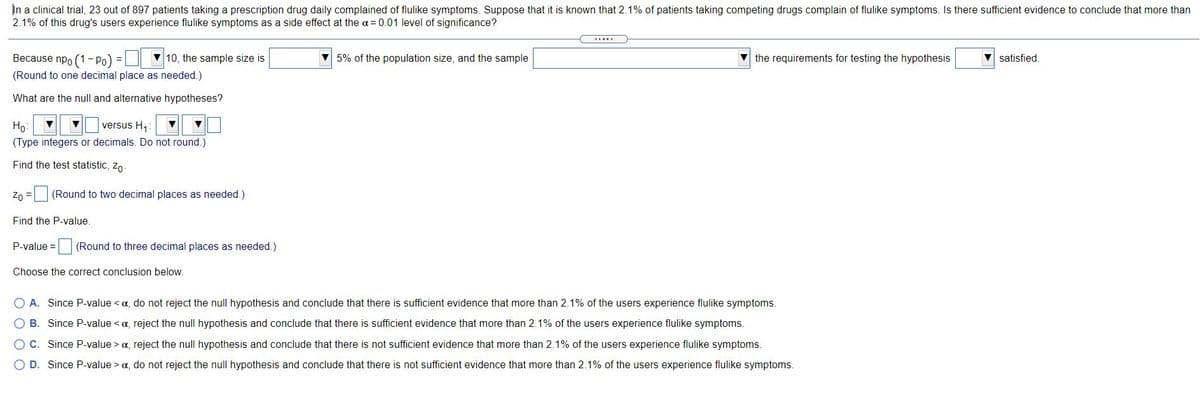(Type inteoers ot decimals. Do not round.) In a clinical trial, 23 out of 897 patients taking a prescription drug daily complained of flulike symptoms. Suppose that it is known that 2.1% of patients taking competing drugs complain of flulike symptoms. Is there sufficient evidence to conclude that more than 2.1% of this drug's users experience flulike symptoms as a side effect at the a=0.01 level of significance? Because npo (1- Po) =D 10, the sample size is v 5% of the population size, and the sample the requirements for testing the hypothesis V satisfied. (Round to one decimal place as needed.) What are the null and alternative hypotheses? versus H, Ho integers Find the test statistic, Zo Zo =(Round to two decimal places as needed.) Find the P.value. P.value = (Round to three decimal places as needed.) Choose the correct conclusion below. O A. Since P-value a, reject the null hypothesis and conclude that there is not sufficient evidence that more than 2.1% of the users experience flulike symptoms. OD. Since P-value >a, do not reject the null hypothesis and conclude that there is not sufficient evidence that more than 2.1% of the users experience flulike symptoms.
(Type inteoers ot decimals. Do not round.) In a clinical trial, 23 out of 897 patients taking a prescription drug daily complained of flulike symptoms. Suppose that it is known that 2.1% of patients taking competing drugs complain of flulike symptoms. Is there sufficient evidence to conclude that more than 2.1% of this drug's users experience flulike symptoms as a side effect at the a=0.01 level of significance? Because npo (1- Po) =D 10, the sample size is v 5% of the population size, and the sample the requirements for testing the hypothesis V satisfied. (Round to one decimal place as needed.) What are the null and alternative hypotheses? versus H, Ho integers Find the test statistic, Zo Zo =(Round to two decimal places as needed.) Find the P.value. P.value = (Round to three decimal places as needed.) Choose the correct conclusion below. O A. Since P-value a, reject the null hypothesis and conclude that there is not sufficient evidence that more than 2.1% of the users experience flulike symptoms. OD. Since P-value >a, do not reject the null hypothesis and conclude that there is not sufficient evidence that more than 2.1% of the users experience flulike symptoms.
MATLAB: An Introduction with Applications
6th Edition
ISBN:9781119256830
Author:Amos Gilat
Publisher:Amos Gilat
Chapter1: Starting With Matlab
Section: Chapter Questions
Problem 1P
Related questions
Topic Video
Question

Transcribed Image Text:In a clinical trial, 23 out of 897 patients taking a prescription drug daily complained of flulike symptoms. Suppose that it is known that 2.1% of patients taking competing drugs complain of flulike symptoms. Is there sufficient evidence to conclude that more than
2.1% of this drug's users experience flulike symptoms as a side effect at the a = 0.01 level of significance?
Because npo (1- Po) =
V 10, the sample size is
5% of the population size, and the sample
V the requirements for testing the hypothesis
V satisfied.
(Round to one decimal place as needed.)
What are the null and alternative hypotheses?
Ho:
versus H1:
(Type integers or decimals. Do not round.)
Find the test statistic, zo-
Zo =
(Round to two decimal places as needed.)
Find the P-value.
P-value =
(Round to three decimal places as needed.)
Choose the correct conclusion below.
A. Since P-value < a, do not reject the null hypothesis and conclude that there is sufficient evidence that more than 2.1% of the users experience flulike symptoms.
O B. Since P-value < a, reject the null hypothesis and conclude that there is sufficient evidence that more than 2.1% of the users experience flulike symptoms.
OC. Since P-value > a, reject the null hypothesis and conclude that there is not sufficient evidence that more than 2.1% of the users experience flulike symptoms.
O D. Since P-value > a, do not reject the null hypothesis and conclude that there is not sufficient evidence that more than 2.1% of the users experience flulike symptoms.
Expert Solution
This question has been solved!
Explore an expertly crafted, step-by-step solution for a thorough understanding of key concepts.
This is a popular solution!
Trending now
This is a popular solution!
Step by step
Solved in 2 steps

Knowledge Booster
Learn more about
Need a deep-dive on the concept behind this application? Look no further. Learn more about this topic, statistics and related others by exploring similar questions and additional content below.Recommended textbooks for you

MATLAB: An Introduction with Applications
Statistics
ISBN:
9781119256830
Author:
Amos Gilat
Publisher:
John Wiley & Sons Inc

Probability and Statistics for Engineering and th…
Statistics
ISBN:
9781305251809
Author:
Jay L. Devore
Publisher:
Cengage Learning

Statistics for The Behavioral Sciences (MindTap C…
Statistics
ISBN:
9781305504912
Author:
Frederick J Gravetter, Larry B. Wallnau
Publisher:
Cengage Learning

MATLAB: An Introduction with Applications
Statistics
ISBN:
9781119256830
Author:
Amos Gilat
Publisher:
John Wiley & Sons Inc

Probability and Statistics for Engineering and th…
Statistics
ISBN:
9781305251809
Author:
Jay L. Devore
Publisher:
Cengage Learning

Statistics for The Behavioral Sciences (MindTap C…
Statistics
ISBN:
9781305504912
Author:
Frederick J Gravetter, Larry B. Wallnau
Publisher:
Cengage Learning

Elementary Statistics: Picturing the World (7th E…
Statistics
ISBN:
9780134683416
Author:
Ron Larson, Betsy Farber
Publisher:
PEARSON

The Basic Practice of Statistics
Statistics
ISBN:
9781319042578
Author:
David S. Moore, William I. Notz, Michael A. Fligner
Publisher:
W. H. Freeman

Introduction to the Practice of Statistics
Statistics
ISBN:
9781319013387
Author:
David S. Moore, George P. McCabe, Bruce A. Craig
Publisher:
W. H. Freeman